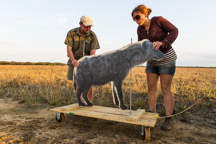Predation exerts an ultimate selective pressure on animal behavior: the fitness consequences of an ineffective behavioral response are immediate and irrevocable. Antipredator defenses, however, also carry fitness costs. Lost time and energy devoted to defensive behaviors or to avoiding “risky” foraging opportunities make the mere threat of predation detrimental to prey growth, survival, and fecundity. Prey must therefore optimize resource acquisition while avoiding predation. An optimal antipredator strategy may involve multiple behaviors performed simultaneously or sequentially, yet surprisingly little research has been conducted on how behaviors interact to counter variations in intensity and type of predation risk. Even fundamental information on the circumstances that elicit particular antipredator behaviors remains under-investigated.
Without such data, theories on the adaptive evolutionary significance of antipredator behaviors remain largely untested, nor can we evaluate and predict behaviorally-mediated effects of predators on herbivore populations, which may in turn significantly affect the ecology of ecosystems as a whole.
Meredith Palmer employs a combination of empirical, experimental, and theoretical approaches to explore how prey ungulates in African large mammal communities utilize a suite of antipredator behaviors to counter a risk-resource tradeoff across a gradient of time and space.
The landscape of fear
The “landscape of fear” hypothesis predicts that the expression of antipredator responses reflect a tradeoff between risk avoidance and energy gain, such that animals avoid areas of high perceived predation risk even if forage is abundant in those areas. While well-established in small-scale experimental systems, it remains unclear whether this tradeoff significantly affects vertebrate behavioral patterns. Meredith is using the Snapshot Serengeti camera trap data on ungulate activity and abundance to test whether fear landscapes affect ungulate foraging decisions. She is modeling the impact of predator hunting strategy and fluctuating resource conditions on the strength of prey avoidance behaviors in response to predictable levels of predation risk.
Localized predator activity
Landscape-level antipredator behaviors may not manifest if prey cannot predict predator activity patterns or are unable to pay the fitness costs of avoiding predators long-term. Prey may compensate for these inabilities - or supplement their broad-scale responses - by instead avoiding areas that predators have frequented within the previous few hours or days. Prey could obtain additional foraging opportunities by utilizing more of the landscape, while suffering compensatory costs from devoting additional time and energy to predator detection and defense. Short-term behavioral changes are rarely investigated, and little information is available on the factors that select for short- over long-term avoidance nor the time-scale (i.e., hours, days, weeks) of these responses. Within the camera trap grid, Meredith has simulated “lion” activity by conducting playbacks of lion roars at a subset of camera sites. We are looking for whether and for how long prey ungulates respond to this artificially elevated risk by avoiding these sites or depressing their activity levels.
Direct predator encounters
Direct encounters with predators remain inevitable. Evading a predator requires reactive responses, such as vigilance, flight, or defense. Prey species do not perform the same antipredator behaviors during every encounter; it is likely that certain reactions are more apt for evading specific types of predators. No study has yet employed a rigorous, repeatable experimental design to parse out which aspects of predator, prey, or environment evoke particular responses and to determine whether responses reflect a broader pattern of ungulate antipredator behavior. Meredith is using life-sized, moving, photo-realistic models to examine the types and intensities of evasive behaviors elicited during simulated predator encounters.



